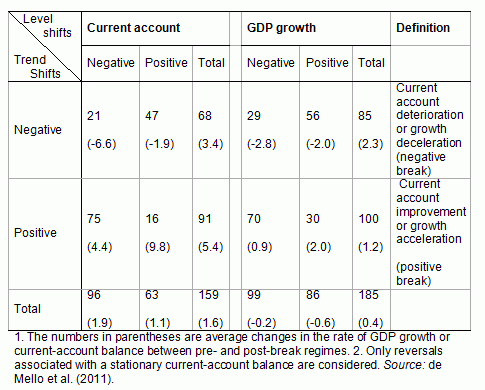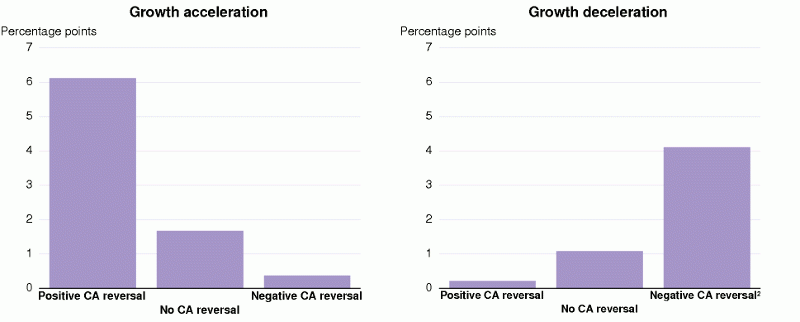Current-account reversals are often disruptive to short-run growth, at least in developing and emerging-market economies (see on this site Abiad et al. 2010 and Böwer et al. 2010). They are usually accompanied by sudden stops in capital flows and large exchange rate depreciations, which in turn trigger banking crises. GDP typically falls relative to trend during or immediately after a reversal but bounces back strongly thereafter, once the drivers of unsustainable external positions, including misaligned exchange rates, have been rooted out. Empirical evidence for industrial economies is less clear-cut.
Considering the long run
Most of the empirical literature has focused on the short-run growth consequences of large improvements in current-account positions, which tend to occur following periods of unsustainable build-up in net foreign liabilities. Here we turn to medium- and long-run outcomes, drawing on our previous work (de Mello et al. 2010 and 2011). We argue that current-account reversals can have long-lasting effects on the economy resulting in structural breaks in trend GDP growth, rather than short-lived deviations of growth from trend. In doing so, we bring the literature on current-account reversals closer to that on the drivers of accelerations or decelerations in a country’s rate of growth of GDP.
A chronology of current-account reversals and breaks in GDP growth
In de Mello et al. (2010), we identified a chronology of 159 current-account reversals in a sample of 101 countries during 1971-2007. The chronology is based on a unit root test that allows for endogenous structural breaks in the levels and trends of current account-to-GDP ratio, rather than only in levels, as in the conventional literature on current-account reversals. We find that for most countries external positions are stationary around breaks. In de Mello et al. (2011), we apply the same methodology to the real rate of GDP growth and identify a chronology of 185 breaks in 113 countries during 1971-2007.
Our chronology of breaks in GDP growth is instructive, because it includes among the four possible outcomes (Table 1) the V-shaped recovery in growth that has been highlighted in the literature in the aftermath of current-account reversals. In our chronology, this particular case combines a fall in the level of GDP growth with a subsequent increase in trend GDP growth and is associated with a post-break increase in GDP growth by 0.9 percentage points on average. Only in about 30% of cases are the shifts in trends and levels mutually reinforcing, in the sense that both breaks have the same sign.
Table 1. Distribution of level and trend breaks
Do current-account reversals have a lasting effect on growth?
To our knowledge, the literature has not yet answered this question. Most studies focus on the short-term effects of current-account reversals, which are found to be negligible in Milesi-Ferreti and Razin (2000), short-lived and related to capital mobility in Edwards (2005), and short-lived and dependent on the pre-adjustment size of current-account imbalances and exchange rate misalignment in Eichengreen and Adalet (2005). Current-account reversals tend to have less disruptive, while still short-lived, effects on growth in industrial countries (Freund 2005; Freund and Warnock 2005; Debelle and Galati 2007).
Our chronology suggests that current-account reversals and trend GDP growth breaks are indeed correlated. The probability that a growth break occurs within one or two years after a current-account reversal is 12.4%, which is significantly higher at classical levels of confidence than the unconditional probability of a growth break, at 5.2%. Moreover, current-account improvements are followed by growth accelerations in nearly all cases detected in our chronology, suggesting a positive association between both outcomes.
To go beyond simple descriptive statistics, we ran several ordered-probit regressions to control not only for the occurrence of a reversal but also for other determinants of breaks in GDP growth. We find that:
- Current-account reversals increase the probability of a break in GDP growth within two years of occurrence of the reversal (Figure 1). An improvement in a country’s external position increases the probability of a pick-up in trend GDP growth by about 4.5 percentage points and reduces the probability of a growth deceleration by 1.3 percentage points. In turn, a current-account deterioration reduces the probability of an impending growth acceleration by 0.9 percentage points, while leaving the probability of a growth deceleration unchanged.
Figure 1. Predicted probabilities
Notes: Probabilities are based on the baseline regression reported in de Mello, Padoan and Rousová (2011) and evaluated at means of the explanatory variables. 2. Corresponds to a non-significant marginal effect. Source: de Mello, Padoan and Rousová (2011).
- Breaks in GDP growth depend on the level and rate of acceleration of GDP growth prior to a break, as well as regional spillover effects, measured by the number of growth accelerations (minus the number of growth decelerations) in the reference country’s geographical area. The level of government indebtedness and the extent of exchange-rate depreciation (correcting for Balassa-Samuelson effects, as in Rodrik, 2008) also affect the probability of a break in trend GDP growth, although these effects are not very robust across specifications.
- Macroeconomic policy matters. Policy actions that have the potential for improving external positions – such as a fiscal tightening when external positions improve or a monetary tightening when external positions deteriorate – could also raise the probability of a subsequent pick-up in trend GDP growth. In particular, in association with a current-account improvement, a reduction in the budget deficit that would cause the debt-to-GDP ratio to fall by 10% over a three-year period prior to a break in GDP growth raises the probability of an impending growth acceleration by 3.3 percentage points. As for monetary policy, an increase in the discount rate by 10 percentage points over a three-year period prior to a break in GDP growth that includes a negative current-account reversal raises the probability of an impending growth acceleration by 0.1 percentage points.
What are the channels through which current-account improvements support growth?
- Current-account improvements may be associated with a lasting reallocation of resources towards higher-productivity uses. To the extent that productivity is higher in the tradable sector, a reallocation of resources away from sectors producing non-tradable goods could cause both the current-account balance to improve in a sustained manner and growth to accelerate. Hausmann et al. (2005) provide evidence in favour of the reallocation hypothesis.
- The link between current-account reversals and structural breaks in GDP growth may be related to the availability of financing. In surplus countries, the future stream of earnings arising from an increase in the stock of net foreign assets could be used to finance pro-growth activities, which could trigger growth acceleration. In deficit countries, the resources used to service net external liabilities could be channelled instead to finance pro-growth activities. By making indebted countries less reliant on foreign financing, an improvement in their external positions would make them less vulnerable to sudden flow reversals.
- An increase in capital inflows that corresponds to a sustainable deterioration of the current-account balance may yield a growth dividend to the extent that foreign savings are used to finance investment in productivity-enhancing activities in the recipient country. If, by contrast, capital inflows are channelled to lower-productivity sectors, such as those producing non-tradables, rather than the more productive tradable sector, additional financing may harm, rather than promote, growth (Aizenmann et al. 2004; Gourinchas and Jeanne 2007; Prasad et al. 2007).
- The growth payoff of a sustained improvement in a country’s external position could be related to the role that domestic savings play in the co-financing of growth-enhancing investment. Co-financing encourages banks to select the most productivity-enhancing projects (Aghion et al. 2006). The link between precautionary saving to finance risky investment in incomplete financial markets also explains the link between higher domestic saving and growth (Sandri 2010).
These channels point towards a growth payoff of current-account improvements, which is in line with our empirical findings. However, our results do not go as far as suggesting that a current-account deterioration is necessarily harmful in the sense of making a growth deceleration more likely. Instead, we find that a current-account deterioration reduces the probability of growth acceleration, which suggests that countries have yet to make the most of capital inflows in support of long-term growth.
Implications for global rebalancing
Our analysis suggests that current-account improvements are desirable, because they have the potential to enhance growth in a durable manner. To the extent that macroeconomic policy also matters, policymakers may face an incentive to pursue current-account improving policies, such as a fiscal tightening when external positions improve or monetary tightening when external positions deteriorate. But, of course, such policies cannot be pursued by all countries at the same time, a situation that nevertheless seems unlikely to happen since our previous research (de Mello et al. 2010) shows that countries with already strong external positions do not have a high probability of experiencing further current-account improvements. Yet, this link needs to be explored further, in particular with reference to the adjustment mechanisms that work to redistribute current-account surpluses among countries and the extent to which policy mechanisms can be improved at the national and multilateral levels to ensure that such redistribution takes place in an orderly fashion.
References
Abiad, Abdul, Daniel Leigh, Marco E Terrones (2010), “Transitioning from large surpluses: What are the costs?”, VoxEU.org, 17 April.
Aghion, Comin and Howitt (2006),"When Does Domestic Saving Matter for Economic Growth?", NBER Working Paper 12275.
Aizenman, J, B Pinto, and A Radziwill (2004), “Sources for Financing Domestic Capital: Is Foreign Saving a Viable Option for Developing Countries?”, NBER Working Papers, 10624.
Böwer, Uwe, Julia Lendvai, Alessandro Turrini (2011), “Can the Baltic economies adjust and grow?”, VoxEU.org, 21 July.
Debelle, G and G Galati (2007), “Current Account Adjustment and Capital Flows”, Review of International Economics, 15:989-1013.
de Mello, L, PC Padoan, and L Rousová (2010), “Are Global Imbalances Sustainable? Shedding Further Light on the Causes of Current Account Reversals”, Economics Department Working Paper, No. 813, OECD, Paris (forthcoming in the Review of International Economics).
de Mello, L, PC Padoan, and L Rousová (2011), “The Growth Effect of Current Account Reversals: The Role of Macroeconomic Policies”, Economics Department Working Paper, 871.
Edwards, S (2005), “Capital Controls, Sudden Stops and Current Account Reversals”, NBER Working Paper, 11170.
Eichengreen, B and M Adalet (2005), “Current Account Reversals: Always a Problem?”, NBER Working Paper 11634,
Freund, C (2005), “Current Account Adjustment in Industrial Countries”, Journal of International Money and Finance, 24:1278-1298.
Freund, C and F Warnock (2005), “Current Account Deficits in Industrial Countries: The Bigger They are, the Harder They Fall?”, NBER Working Paper 11823.
Gourinchas, P-O and O Jeanne (2007), “Capital Flows to Developing Countries: The Allocation Puzzle”, NBER Working Paper 13602.
Hausmann, R, L Pritchett, and D Rodrik (2005), “Growth Accelerations”, Journal of Economic Growth, 10:303-329.
Milesi‑Ferretti, GM and A Razin (2000), “Current Account Reversals and Currency Crises, Empirical Regularities”, in P Krugman (ed.), Currency Crises, University of Chicago Press.
Prasad, ES, RG Rajan, and A Subramanian (2007), “Foreign Capital and Economic Growth”, Brookings Papers on Economic Activity, 38:153-230.
Rodrik, D (2008), “The Real Exchange Rate and Economic Growth”, unpublished manuscript, John F. Kennedy School f Government, Harvard University.
Sandri, D (2010), “Growth and Capital Flows with Risky Entrepreneurship”, IMF Working Paper 10/37.








